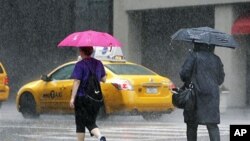Hurricane Irene is paying a visit to much of the U.S. East Coast, inspiring worry, fear, frustration, and - in some cases - a little bit of excitement.
Irene is a big storm, and it is expected to move up the eastern coast of the United States to New York City and Long Island, N.Y. It's the first hurricane that area has seen in years. Will Safer lives on Long Island with his wife and daughter. Safer has been tracking the storm carefully and expects the eye of the hurricane to pass right over them or very close. Safer says that worries him, especially because he has a young child.
"She's 16 months old... and I can tell you that my anxiety level is much, much higher than it's ever been," he said.
Preparing in Virginia Beach
Farther south in Virginia Beach, the family of Shannon Hendrix is staying put. She says her family of six has prepared for a power outage and loss of water service. She also admits some of the locals find weathering the storm a bit of a thrill.
"There's a bit of excitement from the people here who are staying. There's a lot of hurricane parties at bars and at people's houses, and people are stocking up on libations," said Hendrix.
Going even farther south - to the area where Irene made landfall early Saturday - Jill Reuter and her husband and son are staying at a bed-and-breakfast about 50 kilometers from North Carolina's Outer Banks. They were on a beach vacation when the storm started to threaten, so they drove inland and are waiting out the hurricane in Edenton, North Carolina.
"We're going to hole up and we're going to read. And it looks like a chess board here, it looks like there are some things available here to amuse ourselves, and that's what we'll do," she said.
But, she admits, the weather has her a little rattled. "This is an old house with a tin roof; it's been an interesting night."
Assessing damage in North Carolina
In Wilmington, North Carolina, the worst of the storm has passed already. Radio host Bob Workmon spent a sleepless night preparing local news reports on the hurricane, along with several co-workers. They had power from a backup generator, but most of Wilmington was in the dark.
"At this very moment I'm looking at a Progress Energy outage map and it's showing more than 61,000 people without power. That's more than half the population in this county alone," he said.
Weathering the storm in the dark is especially eerie, he said, because without electricity, you can't really see what is going on outside, and there were some funnel [storm] clouds reported. But the worst part of the storm is over for Wilmington, and Workmon is headed home to bed.
Catching it at both ends
And you could say Russ Bissell caught both ends of Hurricane Irene: he lives on Long Island, New York, but traveled south earlier this week to secure a sailboat he keeps off the coast in Oriental, North Carolina, very near where the hurricane made landfall Saturday. The boat is on dry land now and Bissell is back in Long Island awaiting the storm. He's pretty good-humored about it.
"It struck me funny, I have to deal with this hurricane twice."
But he said his concern lies less with his Long Island home or his sailboat than with the people living in North Carolina's flood-prone "low country," who risk losing houses, crops, and livestock. He says no one who has been through a hurricane before will take this one lightly.


















